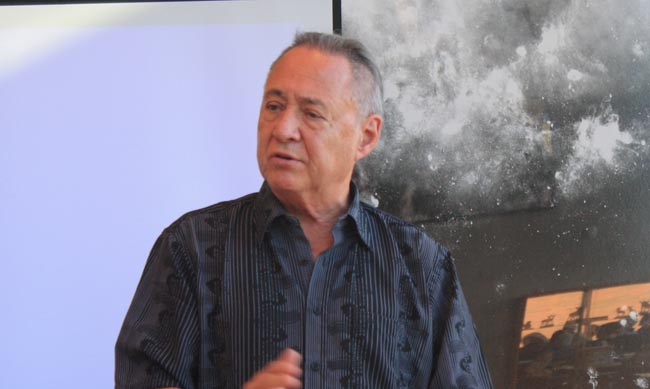Setting targets more important than hitting them

By Maurice Switzer
Part-way through my first-ever archery lesson it struck me as sort of funny that a white guy was teaching an Indian how to use a bow and arrow.
Mind you, a genealogist would have to dig well into the roots of my family tree to find someone who depended on their archery skills to put partridge on the Marsden family table. So my very survival didn’t depend on whether or not Andy Bourgeois could succeed in coaching me to place arrows near the centre of a bull’s-eye 10 or 20 yards away.
My lesson at The Archery Place on Highway 94 near Corbeil was a gift from a First Nation lady friend, and together we did our best to demonstrate to our tutor that he was teaching us a skill that was already well-entrenched in our genes, part of our Indigenous DNA.
I don’t think we fooled Andy, judging by the look on our faces when he handed us a composite bow, which looked like a tool you’d use to jack up your car if you had a flat tire. It looked nothing like I’d ever seen Robin Hood or Crazy Horse use in the movies. It had wheels on both ends, and had to be cranked up with an Allen key that was part of a fancy blue tool Andy never lets out of his sight.
Our instructor seemed incredibly calm, for someone about to place into novice hands a weapon capable of launching a missile that can bring down a bull moose. He did not so much as bat an eyelash when my friend’s first arrow missed not only the coloured target rings but the entire target area, and wound up protruding from the chest of a foam black bear leaning up against the clubhouse wall.
“Whoops!” is about all you can say when that happens. It’s comparable to throwing a bowling ball into the next lane.
Andy retained his composure, like he’d seen it all before and nothing would faze him. Even his friendly black Lab lay calmly panting nearby, blissfully unaware that her life might be in any sort of imminent danger.
Archery is a lot like darts, the basic idea being to land your arrows as close as possible to the small centre section of a target. The etiquette of both sports suggests that it is best to wait for your opponent to remove their missiles from the target BEFORE you start shooting yours at it.
But, unlike darts, archers are advised not to consume frosted mugs of foamy lager while waiting to take their next turn.
By the end of an hour, we Indians managed to put enough arrows into the appropriate places to assure Andy that it was safe to invite us back. No humans or black Labs were injured in the making of this documentary.
My partner and I were in no way disappointed to be introduced to a traditional Indigenous skill by someone whose ancestors were taught it by ours. He was simply the best available teacher.
Only a week earlier, I had attended a conference staged by the North Bay Indian Friendship Centre as part of their Urban Aboriginal Strategy.
One of the most interesting presentations was by David Eddy, CEO of the Vancouver Native Housing Society, which operates 18 buildings in B.C.’s largest city. The most amazing of these is the Skwachays Aboriginal Hotel and Gallery, which transformed a derelict heritage property into a seven-storey architectural masterpiece that provides housing for Native artists, a gallery to sell their work, and a first-class boutique hotel with rooms decorated in Aboriginal themes.
This year the building is expected to bring in $400,000 in combined revenues to help pay down its mortgage.
Someone asked David if he is Aboriginal. If he was offended, he didn’t show it. My guess is there aren’t many Aboriginal people in Canada who have worked for 15 years in social and affordable housing and hold a Master’s degree in Leadership and Training…. at least not yet.
I asked David if he had a succession plan, and he was delighted to say he was grooming two Aboriginal staff members who might someday replace him.
Not so long ago, First Nations people would forfeit their Indian status if they left their reserves to pursue education or careers, so there are still many occupations and professions in which we are not represented. But while a high school diploma was once a rare achievement, there are now First Nation doctors and lawyers, as well as Indian Chiefs. In fact there are all three in the family of Chief Denise Restoule of Dokis First Nation.
There will one day be a First Nations director of Native housing in Vancouver, and maybe an Anishinabek archery instructor in North Bay.
Until then, the main thing is to have targets and always be trying to hit them.
Maurice Switzer is a citizen of the Mississaugas of Alderville First Nation. He is available to deliver public education presentations on Indigenous issues, including treaties.


